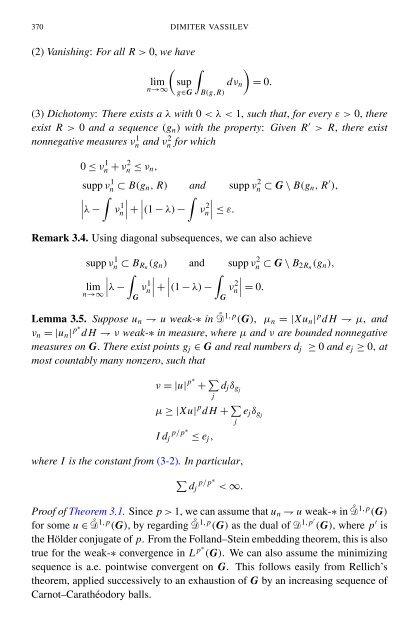Regularity near the characteristic boundary for sub-laplacian operators
Regularity near the characteristic boundary for sub-laplacian operators
Regularity near the characteristic boundary for sub-laplacian operators
Create successful ePaper yourself
Turn your PDF publications into a flip-book with our unique Google optimized e-Paper software.
370 DIMITER VASSILEV<br />
(2) Vanishing: For all R > 0, we have<br />
( ∫<br />
lim<br />
n→∞<br />
sup<br />
g∈G<br />
)<br />
dν n = 0.<br />
B(g,R)<br />
(3) Dichotomy: There exists a λ with 0 < λ < 1, such that, <strong>for</strong> every ε > 0, <strong>the</strong>re<br />
exist R > 0 and a sequence (g n ) with <strong>the</strong> property: Given R ′ > R, <strong>the</strong>re exist<br />
nonnegative measures νn 1 and ν2 n <strong>for</strong> which<br />
0 ≤ ν 1 n + ν2 n ≤ ν n,<br />
supp νn 1 ⊂ B(g n, R) and supp νn 2 ⊂ G \ B(g n, R ′ ),<br />
∫<br />
∫<br />
∣<br />
∣<br />
∣λ − ∣ + ∣(1 − λ) − ∣ ≤ ε.<br />
ν 1 n<br />
Remark 3.4. Using diagonal <strong>sub</strong>sequences, we can also achieve<br />
ν 2 n<br />
supp νn 1 ⊂ B R n<br />
(g n ) and supp νn 2 ⊂ G \ B 2R n<br />
(g n ),<br />
∫<br />
∫<br />
∣<br />
∣<br />
lim ∣λ − ∣ + ∣(1 − λ) − ∣ = 0.<br />
n→∞<br />
νn<br />
1<br />
G<br />
νn<br />
2<br />
G<br />
Lemma 3.5. Suppose u n ⇁ u weak-∗ in ˚1,p (G), µ n = |Xu n | p d H ⇁ µ, and<br />
ν n = |u n | p∗ d H ⇁ ν weak-∗ in measure, where µ and ν are bounded nonnegative<br />
measures on G. There exist points g j ∈ G and real numbers d j ≥ 0 and e j ≥ 0, at<br />
most countably many nonzero, such that<br />
ν = |u| p∗ + ∑ j<br />
d j δ gj<br />
µ ≥ |Xu| p d H + ∑ j<br />
e j δ gj<br />
I d j<br />
p/p ∗ ≤ e j ,<br />
where I is <strong>the</strong> constant from (3-2). In particular,<br />
∑<br />
dj<br />
p/p ∗ < ∞.<br />
Proof of Theorem 3.1. Since p > 1, we can assume that u n ⇁ u weak-∗ in ˚1,p (G)<br />
<strong>for</strong> some u ∈ ˚1,p (G), by regarding ˚1,p (G) as <strong>the</strong> dual of 1,p′ (G), where p ′ is<br />
<strong>the</strong> Hölder conjugate of p. From <strong>the</strong> Folland–Stein embedding <strong>the</strong>orem, this is also<br />
true <strong>for</strong> <strong>the</strong> weak-∗ convergence in L p∗ (G). We can also assume <strong>the</strong> minimizing<br />
sequence is a.e. pointwise convergent on G. This follows easily from Rellich’s<br />
<strong>the</strong>orem, applied successively to an exhaustion of G by an increasing sequence of<br />
Carnot–Carathéodory balls.
















